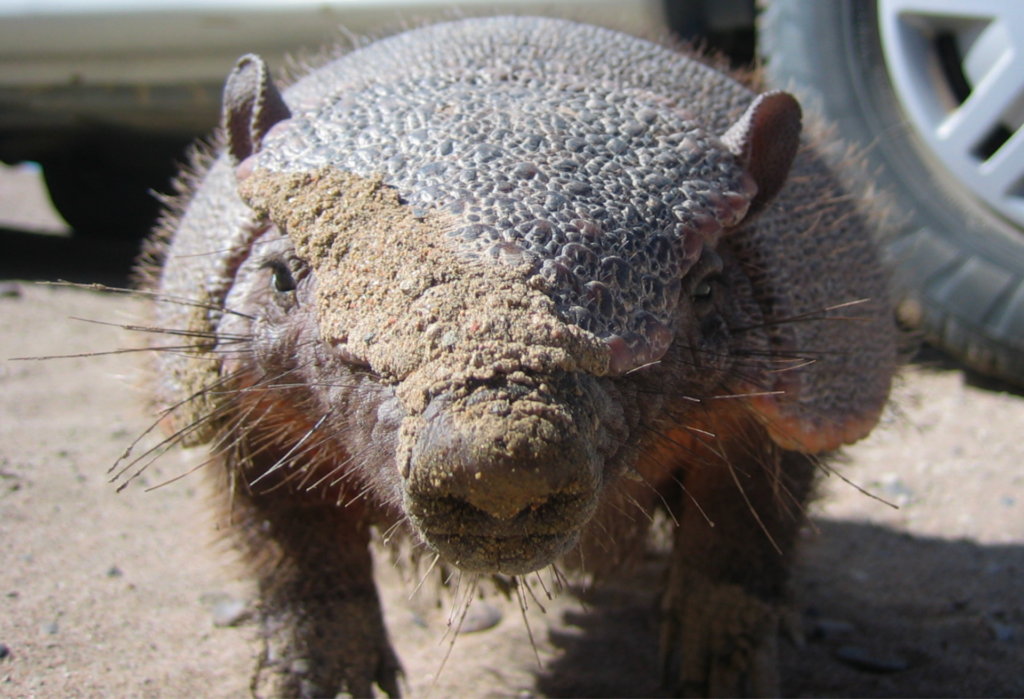Big hairy armadillos and COVID: A warning from the animal kingdom about our pandemic future
By Georgios Pappas | May 29, 2023
 Researchers discovered big hairy armadillos (Chaetophractus villosus) infected with a variant of SARS-CoV-2 that hadn't been reported in humans for months.
Researchers discovered big hairy armadillos (Chaetophractus villosus) infected with a variant of SARS-CoV-2 that hadn't been reported in humans for months.
Armadillos are strange animals. They do not confine themselves to a particular habitat, and they often step out of wildlife environments to ravage human installations, including cemeteries. The plated creatures are omnivorous, too, and this grave habit may lead to contact with human corpses, as Argentinian researchers mused in a preprint about armadillos that had been infected with SARS-CoV-2. Surprisingly, the researchers detected in the armadillos not the prevalent omicron variant of the COVID-19 virus, but a variant of concern that had not turned up in human testing for months. Could the armadillos have contracted the gamma strain from a corpse? More likely infected rodents passed it along, but the authors of the 2022 un-peer reviewed study could not say for sure.
White-tailed deer on the other hand are a friendly species. Also occupying, particularly in the United States, a habitat on the border of humans and wildlife, they came into contact with the virus, of direct or indirect human source, in massive numbers: recent extensive nationwide surveillance in the United States found viral RNA in samples from 13 percent of the animals tested, and serological evidence of past or active infection in 32.1 percent of animals from adequately sampled states, according to two preprints from April 2023. The researchers found extinct variants of SARS-CoV-2 in white-tailed deer, as well as novel variants, unknown to humans. There are other similar examples: New York City rats were found infected with a viral variant a year-and-a-half after its initial human circulation.
All these cases outline how humanity fails to view the whole picture: that the pandemic is an environment-wide event that affects vastly different ecosystems. Presumably zoonotic in origin, SARS-CoV-2 keeps spilling over back outside the human population, finding viral reservoirs or cryptic viral mutational niches. And these new variants emerging in animal species, after they were initially infected by humans, may then go on to infect humans. After all, one of the theories about the origin of the omicron variant, was that it emerged from mice, or other rodents: Human sources (possibly wastewater for example), served as the origin of the animal infection. Although this theory may not be the probable explanation—among other hypotheses, one is that omicron could also have emerged in a chronically infected person—one gets the point: Humans, potentially to their detriment, simply are not aware about the viral circulation, apart from the one among themselves.
It is not as if these reverse spillovers were unexpected. During the first months of the pandemic, such events occurred in numerous mink farms worldwide. When mink origin variants appeared in humans (months before we first learned the soon-to-be ubiquitous term “variants of concern”), the Danish government implemented aggressive control measure and mass mink culling. The governments of Denmark and the Netherlands, in fact, abolished mink farming in their countries, although outbreaks kept emerging on farms in Poland, Lithuania, and Greece. In Poland, surveillance on mink farms in late 2022 and early 2023 picked up a variant closely related to a human variant that had circulated two years prior. Researchers speculated in a recent article that the outbreak may have stemmed from prolonged cryptic viral circulation in an unknown wildlife species such as feral mink or even in cats.
Early on, through experimental and field observations, scientists were aware of several species susceptible to SARS-CoV-2 infection. Researchers have reported that at least 31 different species have been infected with the virus. In one remarkable transcontinental outbreak, pet rodents—bred (and infected) in the Netherlands, shipped to Hong Kong, and distributed to pet shops—were responsible for at least two distinct human transmission chains, a spillback followed by a spillover. Companion animal owners often infected their pets. Early on in the pandemic, zoo animals kept turning up positive, ranging from snow leopards to gorillas. But zoo animals are not placed in crowded cages, as mink in their farms. Animal to animal secondary transmission, when emerging, has not caused major problems, as has been the case when infected house cats have mingled with strays. In order to have a sustained intra-species viral circulation, one needs a species that exists in abundance and tends to live in groups. In these animal populations, viral introduction from humans is not a dead-end event, it’s a potential pandemic trajectory changer.
A recent joint report by the European centers of Disease Control and the European Food Safety Authority classified certain animals as species of concern, based on their ability to transmit the virus. The list included mink, raccoon dogs, cats, ferrets, certain mice and hamster types, white-tailed deer and Egyptian fruit bats.
But what about animal populations of endangered species, ones that are not abundant in numbers? Snow leopards are endangered species and at least four of them have died, infected in zoos. What would happen if the virus entered in bonobo chimpanzee communities? A potential extinction event. And although the International Union for Conservation of Nature released specific guidelines for such endangered populations’ protection, we now enter a phase of loosening protective measures while the virus still circulates widely in humans, who transmit it to animals, which spread it in their own environments, potentially with grave, irreparable environmental consequences.
Policy makers, scientists and the public may have concluded, in their majority, that an acceptable equilibrium in “living with the virus” has been reached. As the medical anthropologist Christos Lynteris notes, there is a profound discussion about “where the virus came from” but no discussion about “where the virus is going.” There is little detection of where the virus circulates in nature, no so-called “One Health” approach that seeks to counter the virus through a holistic understanding of human, animal, and environmental health. It may hurt nature, or it may come back to humans with a vengeance.
It is as if, in an imaginary universal laboratory, the researchers have left some dangerous viral samples unobserved, and never went back to search for them. A (repeated) biosafety breach that no one cares about.
Together, we make the world safer.
The Bulletin elevates expert voices above the noise. But as an independent nonprofit organization, our operations depend on the support of readers like you. Help us continue to deliver quality journalism that holds leaders accountable. Your support of our work at any level is important. In return, we promise our coverage will be understandable, influential, vigilant, solution-oriented, and fair-minded. Together we can make a difference.
Keywords: COVID-19
Topics: Biosecurity
















Several of the wildlife species recognized as being “of concern” in the joint report by European health and food safety authorities have NEVER had a case of Covid-19 (aka SARS2 virus infection) in any wild or farmed populations. This is notably the case for Raccoon-dog, which for many years has been farm-raised for its fur – involving millions of animals each year on commercial farms in China and in many countries in Europe. Also, Raccoon-dog occurs commonly throughout much of China, Japan and elsewhere in southeast Asia. But it also escaped from fur farms in Russia in the 1950s, and… Read more »